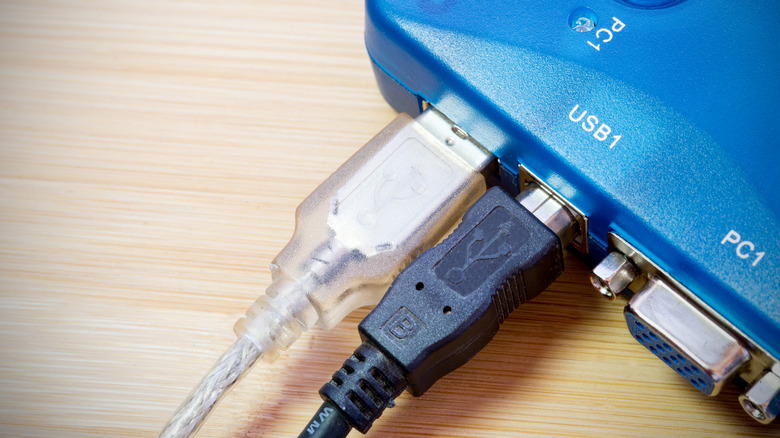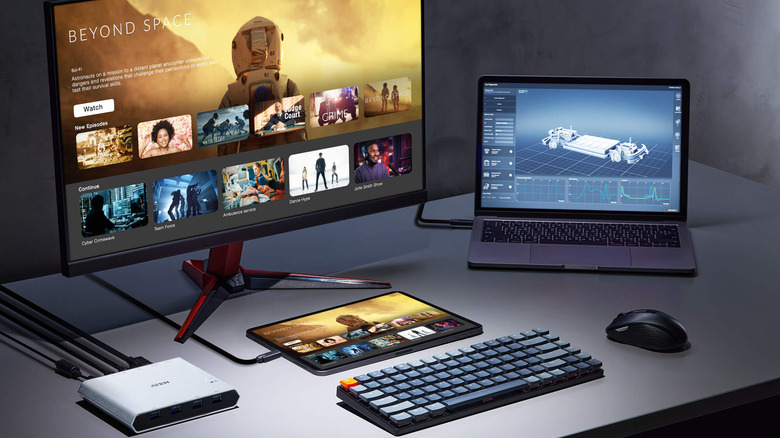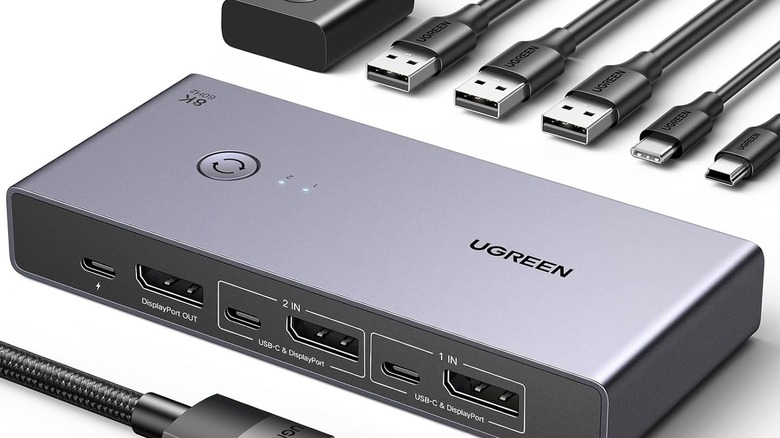What Is A KVM Switch And Who Should Use One?
We may receive a commission on purchases made from links.
A few decades ago, home computers were rare. Not only were they expensive, but they weren't considered very useful for the average person. Having a single computer for an entire family was common. But as computers have become the backbone of our daily lives, growing more portable and affordable along the way, most of us have at least one computer, and many have two or more.
You may have a desktop PC at home and a laptop you take on the go, or maybe you've got a work-issued laptop that lives alongside your personal machine. Compounding the headache, you might even have both a Mac and a PC. You've probably wished you could switch between your computers more easily, especially if you've got an external monitor, mouse, or keyboard you're constantly plugging back and forth.
Luckily, the solution for those juggling multiple computers comes in the form of a little gadget called a KVM switch. The acronym stands for "Keyboard, Video, Mouse" because those are the inputs these devices help you switch from one computer to another. By plugging both computers into a KVM switch, you can seamlessly move a single set of peripherals back and forth. These devices can save you tons of hassle and can also be quite affordable, making them one of the essential home office gadgets. Here's what exactly a KVM switch is, which computer setups can take advantage of them, and how to choose the right one.
What exactly is a KVM switch?
A KVM switch is quite simple in concept. These devices usually look a lot like USB hubs and docks, but instead of simply expanding your computer's port selection, they allow you to share a set of peripherals across two or more computers or devices. For example, let's say you have both a Windows and a Mac laptop but only a single monitor, mouse, and keyboard on your desk. You can plug those interfacing devices into the KVM switch, then plug both of your laptops into it as well. With the press of a button (or sometimes with a physical switch), you can change which laptop those devices are connected to.
KVM switches are available in a range of configurations and price points. The most basic ones worth buying tend to support a monitor using HDMI or DisplayPort along with a couple of USB ports (most commonly type A but occasionally type C) for a mouse, keyboard, and so on. However, you can also find KVM switches that support multiple displays, including at higher resolutions, and have a host of other ports like SD card readers and XLR for professional audio devices. Of course, the bigger and beefier the KVM switch, the more expensive it's likely to be.
Additionally, some monitors have KVM switches built in, allowing you to connect monitors from the top brands to multiple computers. You can then connect your peripherals to USB ports on the monitor and switch between your computers using the monitor's controls.
Who should buy a KVM switch?
Clearly, a KVM switch isn't useful unless you need to share one set of peripherals across multiple computers. But if you think KVM switches are only applicable to those with two laptops, think again. Of course, those with multiple laptops or desktops are a primary use case for these devices, since you can dock both machines into a KVM switch and move between them on the same set of peripherals. But KVM switches can also be useful for other devices. Here are a few more common use cases:
- Multiple game consoles can be connected via a KVM switch to a TV that has too few HDMI ports.
- A gaming console and a computer can be connected via a KVM switch to the same monitor or TV.
- Multiple streaming boxes can be connected via a KVM switch to the same monitor or TV.
- A Samsung Galaxy phone or tablet can be connected to your PC monitor via a KVM switch to run Samsung DeX.
- Musicians can use KVM switches in a studio to let visiting musicians plug in their laptops and use the studio equipment.
- Live streamers can use a KVM switch to toggle between their personal and streaming computers.
This is not an exhaustive list, and you may personally have a unique use case for a KVM switch. The bottom line is that anyone who wants to use the same monitor or peripherals with multiple devices can benefit from owning one.
How to pick the right KVM switch
Knowing whether you would benefit from a KVM switch is easy. What's harder is choosing the right one. With a massive range of switches on the market that vary in price, specifications, and form factor, you'll have to narrow down the perfect one for you by identifying your specific needs.
The first question you should ask is which devices you'll connect to your KVM switch. For example, if you want to connect a mouse, keyboard, HDMI monitor, and a pair of wired headphones, you'll need to find a KVM switch with at least two USB ports, an HDMI port, and a 3.5mm TRS headphone jack. Next, you should decide how many host devices you'll connect to the switch. If you only have two devices to connect — for example, two laptops — most any KVM switch will accommodate that. If you need to connect three or more devices, however, you'll need to make sure you buy a switch to support them all. Additionally, if you plan on connecting devices that can charge through USB-C, make sure your KVM switch has power delivery.
Next, decide what kind of display connection you need between HDMI and DisplayPort, making sure you choose a switch that supports the right version of that standard. For example, if your laptop and monitor both support DisplayPort 2.1, you need a KVM switch with support for DisplayPort 2.1. While you're at it, make sure that your KVM switch also supports the highest refresh rate your monitor is capable of.
Finally, ensure that the USB ports on the KVM switch you choose can support the highest standards your connected devices are capable of. If your computer supports USB 3.2, for example, you'll want a KVM switch with that same capability.



